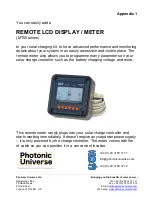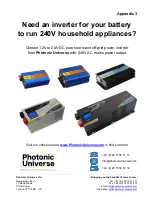
Photonic Universe Ltd
-
Bringing you the benefits of solar power -
Registered office:
Tel: +44 (0) 203 150 11 11
13 David Mews
Fax: +44 (0) 203 150 12 12
Porter Street
Email:
info@photonicuniverse.com
London W1U 6EQ UK
Web shop:
www.photonicuniverse.com
using the load terminals.
The battery fuse should be installed
as close to the “+” battery terminal
as possible, but definitely not
further than 15cm from the terminal. The battery fuse rating should be 15A if your solar kit came with
180W-210W solar panel or 20A if the kit came with 220W-260W solar panel (these ratings are given for a
12V battery system; for 24V battery system, the battery current will halve and fuse ratings should be
adjusted accordingly). The load fuse rating should normally be marginally higher than the load current
consumption, but not higher than 20A. Please refer to the solar charge controller user manual for more
information about installing fuses.
Charging by the engine or another charger
In a vehicle or boat, it is possible that the battery connected to the solar charge controller will also be
charged by an engine from time to time, or another charger such as a mains charger. In such cases, you
don’t have to disconnect the battery from the solar charge controller, but please note the following:
-
When charging the battery by the engine or a mains charger, the voltage at the terminals of the
battery will increase
-
The solar charge controller will detect this increase in voltage and might treat it as if the battery was
fully charged. So the controller might switch solar charging off temporarily.
-
When you stop charging by another charger, the solar charge controller will resume charging the
battery.
Frequently asked questions
Q. What type of batteries can be used with this kit?
A. Any sealed, gel or flooded 12V/24V lead acid battery normally used in caravans, motorhomes, cars,
boats, motor cycles, or in off-grid power systems.
Q. Can the kit charge a bank of several batteries?
A. Yes. The batteries should be the same type, capacity and age. For example, it is possible to connect 2
x 12V batteries (wired in parallel, “+” to “+”,“-” to “-”) to the terminals of the solar controller for a 12V
system.
Q. Can the kit charge 2 separate 12V batteries?
A. Yes, but not at the same time. This kit can only charge one battery or battery bank at a time. If the two
batteries are isolated, then you would need to charge each battery one by one. Remember that the solar
panel and load must be disconnected from the controller before swapping the batteries.
Q. Is there any risk that the solar kit will overcharge my battery?
A. The solar charge controller has a built-in overcharge protection
– it will ensure that your battery is not
overcharged, by reducing the charging current/voltage to the trickle charge level or stopping the charge
completely when the battery is full. However it is your responsibility to make sure that your battery size
and capacity can accept the maximum charging current from the solar panel, which can be up to 20A
depending on the solar panel size.
Q. My battery recharges quickly but does not last very long. I think the solar kit undercharges it?
A. No, this is not a kit problem. Most likely your battery is at the end of its useful life so the capacity has
shrunk. Consider replacing it with our special AGM or gel deep cycle batteries (see Appendix 2).
Q. Does the kit produce less power in the winter than in the summer?
A. Generally the output of the solar kit is proportional to the amount of light falling on the solar panel
surface. If the daytime gets shorter in the winter, the total output of the solar kit will reduce proportionally.
The kit would produce significantly less energy on a dark cloudy day compared to a bright sunny day. The
output would also reduce if the sun is low in the sky, compared to when the sun is high in the sky.

























